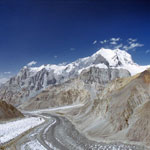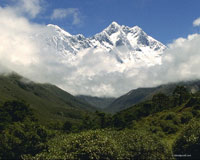|
|
|
Uzbekistan,
history, Uzbekistan history, Uzbekistan and church, church, churches, Christian,
Christian churches, Baptist, Baptist church, Uzbekistan Baptists, summer camp,
summer camps, summer camp for kids, holiday camp, Uzbekistan Baptist union,
Bible Society, Uzbekistan Bible Society, Tashkent, central Asia.

O'zbekiston Bibliya Jamiyati
Bible Society of Uzbekistann
|
Early Asian Christianity.
The story of Christianity in the West has often been told, but the history
of Christianity in the East is not as well known. The seed was the same: the
good news of Jesus Christ for the whole world, which Christians call "the
gospel." But it was sown by different sowers; it was planted in different
soil; it grew with a different flavor; and it was gathered by different
reapers.
But it is generally known that the Church began in Asia. Its earliest
history, its first centers were Asian. Asia produced the first known church
building, the first New Testament translation, perhaps the first Christian
king, the first Christian poets, and even arguably the first Christian
state. Asian Christian endured the greatest persecutions. They mounted
global ventures in missionary expansion the West could not match until after
the thirteenth century. By the Nestorian church (as most of the early Asian
Christian communities came to be called) exercised ecclesiastical authority
over more of the earth than either Rome or Constantinople.
One reason, of course, for the neglect of the Asian dimension in church
history is the comparative paucity of available source materials on the
Eastern roots of Christianity outside the Roman Empire. The surviving
documents are too slender a base to support some of the bold and
contradictory statements made about these earliest Christians of the East.
One historian, for example, calls the Nestorian the greatest missionaries
the world has ever seen. Another dismisses them as "passionless" Christians
embarrassingly obsequious to the politically powerful. The same kinds of
contradictions persist in theological arguments about early Asian
Christianity. To some Nestorians are heretics, condemned by the ecumenical
councils. To others they are ancient and apostolic Asian Christians
untainted by the perversions of Western Greek philosophy. And, of course,
many have forgotten the Nestorians altogether.
Nestorian Church.
Nestorian Church, a communion of Eastern Christians, who follow the
teachings of Nestorius, archbishop of Constantinople, condemned as a heretic
by the Council of Ephesus in 431. Most Nestorians, numbering about 176,700,
live in Iraq, Syria, and Iran, where they are generally known as Assyrians.
Headed by a patriarch, at present residing in Iraq, they reject the
doctrine, defined at Ephesus, that affirms that Jesus Christ is one single
divine hypostasis (person), and that consequently his mother, Mary, should
be called "Mother of God." Nestorian doctrine, following the teachings of
the great exegete Theodore of Mopsuestia, insists on the distinctiveness of
divinity and humanity in Jesus, which leads its critics to accuse Nestorians
of believing that Christ was two distinct persons-the Son of God and the son
of Mary.
The Nestorians crystallized into a separate religious body when a large
group of them immigrated (489) to Persia to escape persecution within the
Roman Empire. The intellectual center of the Persian Nestorians was the
school they established at Nisibis, Persia, and under the leadership of the
Catholicos of Seleucia-Ctesiphon, they also established bishoprics in Arabia
and India. Occasionally persecuted by Persian Zoroastrians, they were
granted legal protection by Muslims after the Arab conquest (637) of Persia.
Between the 7th and the 14th centuries Nestorian communities were
established, through an extraordinary missionary effort, in Central Asia,
Mongolia, and China. They were later absorbed by Islam.
Asian Christianity.
The term "Asian Christianity" is open to more than one interpretation. For
more clear understanding it is better to use it culturally, not strictly
geographically. Bethlehem, Jerusalem, Antioch and Armenia are all
geographically in Asia, but politically and to a considerable extent
culturally they belonged sooner or later to the West, that is, to the Roman
Empire until the Muslim conquest. "Asian Christianity" refers to the
churches that grew and spread outside the Roman Empire in ancient oriental
kingdoms east of the Euphrates and stretching along the Old Silk Road from
Osrhoene through Persia to China or along the water routes from the Red Sea
around Arabia to India.
Before the end of the first century the Christian faith broke out across the
border of Rome into "Asian" Asia. Its first roots may have been as far away
as India or as near as Edessa in the tiny semi-independent principality of
Osrhoene just across the Euphrates. From Edessa, according to tradition, the
faith spread to another small kingdom three hundred miles farther east
across the Tiger River, the kingdom of Adiabene, with its capital at Arbela,
near ancient Nineveh. By the end of second century, missionary expansion had
carried the church as far east as Bactria in what is now northern
Afganistan, and mass conversions of Huns and Turks in central Asia were
reported from the fifth century onward.
In Bukhoro region (formerly a vast Persian area in Central Asia) before it
was captured (early 8th century) by the Arabs, the process of town formation
was very active, ancient settlements surrounding Bukhoro have developed into
the towns of Varakhsha, Vardanzi, Ramish (Ramitan), Kermine, Paikend. All
these towns had more or less a similar structural pattern: the arks
(citadel), the shakhristan - well-planned residential core, necropolis
beyond the town limits and the church building. Bukhoro itself also followed
this pattern of development. The rectangular of Bukhoro shakhristan was cut
into four sections by two crossing main streets which led to gates opening
out on four sides of the world. The Christian temple stood at the eastern
gate of Bukhara.
By the end of the seventh century Persian missionaries had reached the "end
of the world", the capital of T'ang-dinasty China.
But by then a cloud from the desert, Islam, was about to bring this first
period of Asian church history crashing to a close. It was not the end,
however. Out of Asia after another six hundred years, came another cloud, a
storm of Mongol nomads racing west, destroying all before them and
threatening the very center of medieval Christianity in Europe.
The Christianity return into
Central Asia.
The term Central Asia is sometimes used to denote the inclusion of adjacent
portions of China, Mongolia, Afghanistan, Iran, and the Himalayan lands.
But, arguably , more commonly Central Asia a designation for a region of
western Central Asia extending from the Caspian Sea on the west to China on
the east; the southern boundary is formed by Iran and Afghanistan. The
northern boundary is less clearly defined. One interpretation placed it at
the southern border of the Kazakhstan, while another placed it at the
northern border of the Kazakh Republik. Still other interpretations placed
the boundary somewhere between the two extremes. Administratively, during
the Soviet period, the region comprised the following SSR's: Tadzhik (also
spelled Tajik), Turkmen, Uzbek, and Kirghiz (also spelled Kyrgyz), and
portions of the Kazakh SSR, the size of which depended on the placement of
the northern boundary. Russian domination of the area dates from the second
half of the 19th century, before which much of the territory was ruled by
the khanates of Bukhoro, Khiva, and Kokand.
The Christianity has come back to this region in form of Russian Orthodox
Church simultaneously with Russian domination. The influence of this church
as a rule did not overstep the limits of Russian colonial community. But by
the end of the eighteenth century other movements already existed in the
religious life of Russia. Those movements were able to play more important
role in Christianity dissemination.
Molokans, Baptist, Mennonites
in Central Asia and Uzbekistan.
The Molokans were followers of Russian national form of Protestantism. They
have rejected the formalities of Russian Orthodox Church, but they did not
have a clear Evangelical doctrine. Therefore when the Baptist movement had
gained ground in Russia, most Molokans became Baptists. By 20th century the
most of Baptist Churches in Russian empire half consisted of former
Molokans. Many colonists who have migrated to Central Asia were Molokans or
Baptists. The Molokans were skilled farmers. In nineteenth century their
settlements existed all over the Central Asia right up to the border with
Iran in actual Turkmenistan at the present time. Besides new opportunities
the resettlers were looking for more freedom in religious life.
The third component of the Evangelical Christianity in Central Asia became
the Mennonites. They were German resettlers, who left homeland and then also
their settlements in Russia for Mennonites wished to escape military service
both in Germany and in Russian army.
The first Uzbekistan Baptist
congregations.
The first Baptist congregations in Uzbekistan have been started at the close
of the nineteenth century at small towns near to Tashkent (Gazalkent,
Karabog, Iskander) where the population were mostly consisted of the
colonists from Russia. The extant Gazalkent Baptist congregation is oldest
in Uzbekistan. The oldest Tashkent Baptist congregation has been started in
1905 from the group of the military. To our time, this congregation is the
largest in Uzbekistan (about 600 members).
Uzbekistan Baptist, Evangelical Christianity under the soviet regime.
The soviet regime harassed the Baptist (as well as other Evangelical
Christianity denominations) sore and showed them little mercy. Since 1932
till 1944 the Baptist churches activity was possible only in form of
secrecy. Even being officially allowed Evangelical Christianity was always
persecuted by soviet authorities.
Baptist Union in Uzbekistan.
The Baptist Union had been set up in Uzbekistan in 1925. Today the Baptist
Union in Uzbekistan unifies near 30 congregations throughout the country
that consist of near 1800 believers.
The cited sources:
Samuel Maffett, A History of Christianity in Asia.
L. Mankovskaya, Bukhara. From the history of the city.
Rev. John Meyendorff, Nestorian Church.
|

|
Communism Peak and Korzhenevskaya Peak expedition
Communism (Ismoil Somoni) Peak (7495 m) and Korzhenevskaya (7105 m) Peak
expedition. Mountaineering program (39 days).
|
|

|
Lenin Peak Fixed Dates Guided
"Lenin peak" with experienced guide. Dates: Dates:
|
|

|
Special offer Lenin Peak
Expedition to Lenin Peak with guaranteed installed high altitude tents on 5300
m, 6200 m; group equipment: rope, gas and gas stoves, cooking set; high altitude
food
|
|

|
Backcontry camp at Lenin peak
Before hundreds of climbers from all over the world come and lay the path to the
summit. Before the Camps 5300m and 6100m are overcrowded. This is the time when
every step of the previous climber is not possible to find the next day. Dates:
10.06-19.06 & 20.06-29.06
|
|

|
Fixed dates expedition to Lenin Peak
9 July to 31 July & 29 July to 20 August. With an experienced high altitude
guide; Installed high altitude tents on 5300 м and 6200 м; Group equipment:
rope, gas and gas stoves, cooking set; High altitude food.
|
|

|
Speed climbing to Lenin peak.
Speed ascent to Lenin peak- III. It starts Jul. Lenin Peak is the highest summit
of Zailiysky Range. Its height is 7134 meters above sea level.
|
|

|
Expedition «3 7000+m peaks of Pamir» Expedition «3 7000+m peaks
of Pamir» Basic program Bishkek-Bishkek
|
|

|
Lenin Peak Expedition
Facts of Lenin Peak. In accordance with your desire we can arrange a summit
attempt expedition on any of these three routes chosen by you.
|
|
© 2003 - 2016
|


dmitriy.page
|
Uzbekistan Links
Tashkent Links
Samarkand Links
Bukhara Links
Khiva Links





|
|















